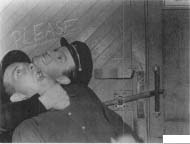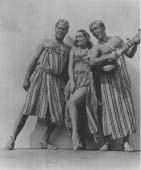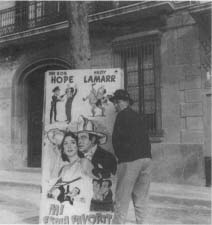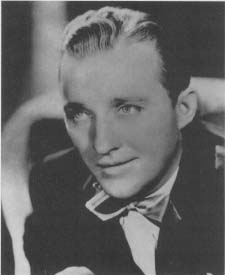Bing Crosby (95 page)
Authors: Gary Giddins

Bing, the silent-comedy connoisseur, affects a Chaplinesque stance during one of his countless charity golf matches with Bob
Hope, who almost always lost.
Bill Milkowski Collection

Bing and Bob wrestle during a break on
Road to Singapore,
1939. Usually they wrestled over lines.
Bill Milkowski Collection

Dorothy Lamour had to fight for her every line once Bob and Bing got started. Np one expected
Road to Singapore
to break attendance records and begin a twenty-year series.
Gary Giddins Collection

The fake feud between Bob and Bing continued for thirty-seven years. During a trip to Spain in 1953, Bing could not resist
taking his best shot.
Susan Crosby Collection

By 1940 Bing was on top, but all he had achieved would soon seem like a mere prelude to what was to come during the war and
after.
Gary Giddins Collection
Indeed, the producer claimed he auditioned 1,583 kids for the picture. Several incidents from those tryouts were added to
the script, including the child who turned out to be a midget and the girl who would not sing despite her mother’s panicked
pleas. Bing had fun on the set. The newsboys bought him a cake to celebrate his assumed thirty-sixth birthday. When Dante
failed to hear the director call cut and kept dancing, Bing put his hat on him and it came down to his mouth. Nearly sixty
years later, Dante married Rosemary Clooney, who remembered an incident in the 1970s, when they were in a pro shop: “Bing
said to Dante, Try on this hat, and he took off the hat and threw it to him and the hat went down to the same place as when
he was a kid. ‘Cause Bing had a big head. So Dante said he felt just exactly the same way as he did back then. Oh God, it
was funny, to see the admiration Dante had for Bing after all those years.”
7
On several occasions Bing brought his own kids to the set to show off the three-part harmonies of Gary (almost six) and the
twins (almost five).
That some uneasiness also existed is evident from Bing’s understated remark when asked, in 1976, about his most difficult
film. “I’ve done some pictures where you didn’t quite know where they were going,” he answered. “I remember a picture called
The Star Maker.
The director didn’t like the picture but he had to do it — a guy named Roy Del Ruth, he was a good director — and the atmosphere
on the set wasn’t too congenial because of that. Roy always treated me very
well but wasn’t happy because he disliked things they had done with the script, but he had to go ahead with it. And that’s
the only picture I can think of where there was even a smidgen of unpleasantness.”
8
On one occasion, as Barry Ulanov reported, Bing exercised his power with unruffled dispatch. By this time the star was accustomed
to disbursing bit parts to old friends on their uppers. He examined the cast lists for possibilities and asked assistant directors
to call the people he had in mind, leaving Bing’s name out of it. Bing had asked Del Ruth’s man to contact a friend to play
an elevator operator. Making up one morning, he noticed someone else in the role and asked Del Ruth, “What happened? Couldn’t
you get the guy I suggested?” Del Ruth told him, “We didn’t try. We thought this fellow would be better.” Bing nodded, “Well,
maybe you’re right.”
9
He took off his toupee and observed what a lovely day it was, perfect for golf. Del Ruth quickly assured Bing that he would
get hold of his choice right away and that both actors would get paid.
Bing was in superb voice. The old songs suited him as well as the new ones or better, especially the non-Edwards relic “I
Wonder Who’s Kissing Her Now,” beautifully sung by Bing to encourage a shy little girl during an audition and prettily shot
by Karl Struss, who elsewhere puts shadows on Bing’s cheeks and focuses on his big, limpid eyes. In several scenes he is more
aggressive than usual, reciting self-righteous speeches, but is splendidly disarming when teaching the kids confidence in
a number that begins with a rhyming section reminiscent of Bert Williams and turns pure Bing as he sidles into Burke and Monaco’s
“Go Fly a Kite.” As usual, he was billed after the title card, this time with five other cast members, undistinguished but
for Ned Sparks, who was never funnier than as Larry’s child-loathing publicist.
The Star Maker
received respectable reviews and made lots of money, beating the competition in almost every city. Paramount took a full-page
ad, headlined BI
N
G BUSINESS! — inexplicably crowing that it outgrossed its own competing blockbuster, Cecil B. De Mille’s
Union Pacific,
in seven markets, from San Francisco to Boston. Louella Parsons praised Bing for daring to appear with those little “picture
stealers,” noting, quite rightly, “Never have the old songs been sung with more feeling. Yesterday’s favorite tunes take on
a new flavor when Bing croons them.”
10
Time
agreed that he sang them “as
well as they have ever been sung” and praised the movie as “an engaging archaeological exploration into a vanished world of
the U.S. amusement industry,”
11
which was certainly true of the elaborate “School Days” number, with Bing in mortarboard, goatee, and glasses on the tip
of his nose.
Despite
The Star Maker’s
success, Linda Ware disappeared, and poor ailing Gus Edwards, who lived another six years, got little in the way of a professional
boost. One of the studio’s publicity stunts was an August 18 dinner in his honor at the Ambassador Hotel. It attracted freeloading
newsmen in large numbers, but few luminaries. Bing was not present. The day before the premiere, he played in a California
state golf championship at Del Monte, then went straight to Rancho Santa Fe, some said as an excuse to miss the opening. “One
thing is certain,” a
Time
correspondent memoed his editor, “after he is through with a picture Crosby treats his time as his own, won’t go sailing
around the country for studio publicity.”
12
The Star Maker,
compromised though it is by the producer’s ambition to create a star, added to Bing’s prestige as an entertainer who covered
the waterfront of American show business. It also helped usher in a new genre in musicals: sham biographies of popular entertainers
who made their mark before or beyond movies. Many films were made in the 1930s about nineteenth-century composers — half a
dozen about Johann Strauss alone. Many others exploited pop gossip. (Jolson decked Walter Winchell in 1933 for writing a Russ
Columbo melodrama,
Broadway Through a Keyhole,
that everyone knew was about Ruby Keeler’s involvement with a gangster before she married Jolson.) But the only major attempt
at dramatizing the story of a great showman was MGM’s lavish and immensely successful
The Great Ziegfeld,
in 1936.
Suddenly, in 1939, Paramount, Fox, and RKO turned out five musical biographies. Like
The Star Maker,
Fox’s
Rose of Washington Square
used a pseudonym for its thinly disguised depiction of Fanny Brice, but that was made without Brice’s consent — she sued
and won a settlement. Real names were used in films purportedly telling the stories of Stephen Foster, Victor Herbert, and
Vernon Castle, but they were dead, though Vernon’s wife and dancing partner, Irene, allowed RKO to turn their marriage into
a Fred and Ginger vehicle.
After Michael Curtiz directed James Cagney in the glimmering
Yankee Doodle Dandy
(George M. Cohan) in 1942, the floodgates opened: dozens of biopics, none as good, all of them fictitious, many ludicrous,
especially in the casting: Victor Mature as Paul Dresser, Mickey Rooney as Larry Hart, Robert Walker as Jerome Kern (Jews
were always played by conspicuously gentile Gentiles). Bing partook of the idiom, playing minstrel Dan Emmett in
Dixie
(1943) and testing as Will Rogers for a picture David Butler tried to launch.
Yet
The Star Maker
represented for Bing not an entry into a new decade but the closing of a door on the old. Where could he have gone from there?
Screening Bing’s last picture of the 1930s, how could studio bosses fail to recognize a sad portent, a future of conventional
marital amusements, a dozen versions of the same script: misunderstanding at breakfast, song, compromising situation with
a secretary, song, mistaken identities, song, denouement, song. Yes, Bing was a far more accomplished actor than ever before,
but he was also considerably harder to cast. His comedy was mellow, not brazen; his personality likable, not fervent. He could
no more essay Cary Grant screwballs than Errol Flynn swashbucklers. Bing created the quintessential light leading man with
a stunning voice, and — though he had not enjoyed a genuine smash since
Waikiki Wedding
— his popularity continued to hold. In 1939 he was Paramount’s top-ranked male draw (ahead of Ronald Colman, Gary Cooper,
and Jack Benny) and Universal’s second-ranked (after Charles Boyer).
13
But no one could predict how his persona might develop beyond the sort of decorous romances that sneaked up on him throughout
the 1930s.
A transformation loomed ahead, triggered by the February 1940 release of
Road to Singapore.
In the brief interval before that picture began shooting, Bing concentrated on his recording career, continuing the prolific
schedule of 1938. Usually, records had to be sacrificed when Bing was juggling a movie and his radio show, and not just because
of time constraints. Each film required prerecording sessions; additional pressure on his voice was considered reckless. Yet
between March and June — before and after
The Star Maker
— Kapp managed to squeeze in nearly a dozen sessions, eking out more than two dozen hits, though no megahits; it was the
year (1939) when Glenn Miller’s sugared swing and Kay Kyser’s infantile gimmicks held sway.
Every change in Bing’s vocal style precipitated an alteration in his stature, in the nature of his renown. This Kapp understood
too well. Just as Bing’s recent movies prefigured an increasingly housebroken maturity, so his new records would reflect his
standing as a classicist, the troubadour laureate of American song. Considering Crosby’s beginnings at Decca (“Just a-Wearyin’
for You”) and the wistful successes of 1938, Kapp’s increasingly retro direction was surprising only in its tenacity. The
good and the bad went hand in hand: Bing made many exceptional records in 1939 while hacking his way through sentimental fluff,
patriotic airs, and songs from his own distant past. As always, his primary recording obligations were his movie songs, which
occasioned few complaints — the Deccas were often vastly superior to the screen versions. For the rest, he was saddled with
a profusion of mossy evergreens, and looking backward more often than ahead.
